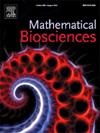A stochastic model of prion dynamics with conversion and fragmentation
IF 1.8
4区 数学
Q2 BIOLOGY
引用次数: 0
Abstract
Prions are infectious proteins that, when misfolded, propagate their abnormal structure and cause degenerative diseases in humans and other mammals. The infectious units of prion diseases are aggregates of misfolded proteins, which grow by recruiting normal proteins (conversion) and break down into smaller aggregates (fragmentation).
We introduce a stochastic model describing the dynamics of a population of prion aggregates. The model is formulated as a continuous-time Markov chain that tracks both the number of aggregates and the total number of misfolded protein monomers within aggregates. We derive and solve a PDE for their joint probability generating function, establish results on population growth and mean aggregate size, and analyze how model parameters influence aggregate population dynamics.
具有转换和碎裂的朊病毒动力学随机模型
朊病毒是一种传染性蛋白质,当错误折叠时,会传播其异常结构,并在人类和其他哺乳动物中引起退行性疾病。朊病毒疾病的传染单位是错误折叠蛋白质的聚集体,它们通过招募正常蛋白质(转化)而生长,并分解成更小的聚集体(破碎)。我们引入了一个随机模型来描述朊病毒聚集体的动态。该模型被表述为一个连续时间马尔可夫链,它可以跟踪聚集体的数量和聚集体内错误折叠的蛋白质单体的总数。我们推导并求解了它们的联合概率生成函数的偏微分方程,建立了种群增长和平均种群规模的结果,并分析了模型参数对种群动态的影响。
本文章由计算机程序翻译,如有差异,请以英文原文为准。
求助全文
约1分钟内获得全文
求助全文
来源期刊

Mathematical Biosciences
生物-生物学
CiteScore
7.50
自引率
2.30%
发文量
67
审稿时长
18 days
期刊介绍:
Mathematical Biosciences publishes work providing new concepts or new understanding of biological systems using mathematical models, or methodological articles likely to find application to multiple biological systems. Papers are expected to present a major research finding of broad significance for the biological sciences, or mathematical biology. Mathematical Biosciences welcomes original research articles, letters, reviews and perspectives.
 求助内容:
求助内容: 应助结果提醒方式:
应助结果提醒方式:


